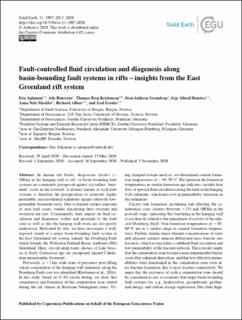| dc.description.abstract | In marine rift basins, deep-water clastics (>200 m) in the hanging wall of rift- or basin-bounding fault systems are commonly juxtaposed against crystalline “basement” rocks in the footwall. A distinct feature of such fault systems is therefore the juxtaposition of relatively highly permeable, unconsolidated sediments against relatively low-permeable basement rocks. Due to limited surface exposure of such fault zones, studies elucidating their structure and evolution are rare. Consequently, their impact on fluid circulation and diagenesis within and proximal to the fault zone as well as into the hanging wall strata are also poorly understood. Motivated by this, we here investigate a well-exposed strand of a major basin-bounding fault system in the East Greenland rift system, namely the Dombjerg Fault which bounds the Wollaston Forland Basin, northeast (NE) Greenland. Here, syn-rift deep-water clastics of Late Jurassic to Early Cretaceous age are juxtaposed against Caledonian metamorphic basement.
Previously, a ∼ 1 km wide zone of pervasive pore-filling calcite cementation of the hanging wall sediments along the Dombjerg Fault core was identified (Kristensen et al., 2016). In this study, based on U–Pb calcite dating, we show that cementation and formation of this cementation zone started during the rift climax in Berrisian–Valanginian times. Using clumped isotope analysis, we determined cement formation temperatures of ∼ 30–70 ∘C. The spread in the formation temperatures at similar formation age indicates variable heat flow of upward fluid circulation along the fault in the hanging wall sediments, which may root in permeability variations in the sediments.
Calcite vein formation, postdating and affecting the cementation zone, clusters between ∼ 125 and 100 Ma in the post-rift stage, indicating that fracturing in the hanging wall is not directly related to the main phase of activity of the adjacent Dombjerg Fault. Vein formation temperatures at ∼ 30–80 ∘C are in a similar range as cement formation temperatures. Further, similar minor element concentrations of veins and adjacent cements indicate diffusional mass transfer into fractures, which in turn infers a subdued fluid circulation and low permeability of the fracture network. These results imply that the cementation zone formed a near-impermeable barrier soon after sediment deposition, and that low effective permeabilities were maintained in the cementation zone even after fracture formation, due to poor fracture connectivity. We argue that the existence of such a cementation zone should be considered in any assessments that target basin-bounding fault systems for, e.g., hydrocarbon, groundwater, geothermal energy, and carbon storage exploration. Our study highlights that the understanding of fluid flow properties as well as fault-controlled diagenesis affecting the fault itself and/or adjacent basinal clastics is of great fundamental and economic importance. | en_US |

